



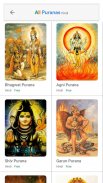
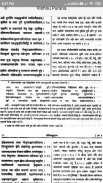
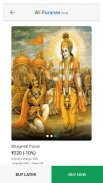
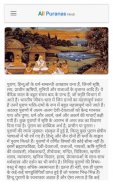
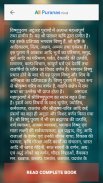
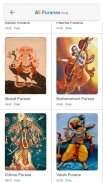
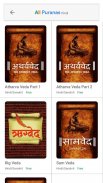
All Puranas Hindi

Description de All Puranas Hindi
The word Puranas (Sanskrit: पुराण) literally means "ancient, old", and it is a vast genre of Indian literature about a wide range of topics, particularly myths, legends, and other traditional lore. Composed primarily in Sanskrit, but also in Tamil and other Indian languages, several of these texts are named after major Hindu deities such as Vishnu, Shiva, and Devi. The Puranic genre of literature is found in both Hinduism and Jainism.
The Puranic literature is encyclopedic, and it includes diverse topics such as cosmogony, cosmology, genealogies of gods, goddesses, kings, heroes, sages, and demigods, folk tales, pilgrimages, temples, medicine, astronomy, grammar, mineralogy, humor, love stories, as well as theology and philosophy. The content is highly inconsistent across the Puranas, and each Purana has survived in numerous manuscripts which are themselves inconsistent. The Hindu Puranas are anonymous texts and likely the work of many authors over the centuries; in contrast, most Jaina Puranas can be dated and their authors assigned.
There are 18 Maha Puranas (Great Puranas) and 18 Upa Puranas (Minor Puranas), with over 400,000 verses. The first versions of the various Puranas were likely composed between the 3rd- and 10th-century CE. The Puranas do not enjoy the authority of a scripture in Hinduism but are considered a Smriti.
Agni Puran, Bhagavata Puran, Brahma Puran, Brahmanda Puran, Brahmavaivarta Puran, Garuda or Garun Puran, Kurma Puran, Linga Puran, Markandeya Puran, Matsya Puran, Narada Puran, Padma Puran, Shiva Puran, Skanda Puran, Vamana Puran, Varaha Puran, Vayu Puran, Vishnu Puran are 18 Maha Puranas.
Garuda or Garun Puran is most read puran in India and also Shiv Puran and Vishnu Puran also read wildly in Indian culture. Agni Puran, Bhagavata Puran, Brahma Puran, Brahmanda Puran, Brahmavaivarta Puran, Kurma Puran, Linga Puran, Markandeya Puran, Matsya Puran, Narada Puran, Padma Puran, Skanda Puran, Vamana Puran, Varaha Puran, Vayu Puran are the Purans which are often chosen by the Spiritual scholars.
They have been influential in the Hindu culture, inspiring major national and regional annual festivals of Hinduism. Their role and value as sectarian religious texts and historical texts have been controversial because all Puranas praise many gods and goddesses and "their sectarianism is far less clear cut" than assumed, states Ludo Rocher. The religious practices included in them are considered Vaidika (congruent with Vedic literature) because they do not preach initiation into Tantra. The Bhagavata Purana has been among the most celebrated and popular text in the Puranic genre and is of non-dualistic tenor. The Puranic literature wove with the Bhakti movement in India, and both Dvaita and Advaita scholars have commented on the underlying Vedantic themes in the Maha Puranas. Puran in Hindi translation is easy way to read puran at ease.
Vishwakarma Purana or Vishwa karma Purana also included in this app Vishwakarma has 4 parts. You can find all 4 parts of Vishwakarma puran in this app.
Kalki Purana and Surya Purana also included in this app.
Apart from Puranas we also provide Bhagwat Geeta, Ramayana, Mahabharata, Rig veda, Yajur Veda, Arthav Veda, Sam Veda and all upnishadas.
We also have provide books containing lectures of great leaders like Swami Vivekananda and Osho.
We have a huge collection of other devotional and religious books most of them are from Hindu Religion.
Le mot Puranas (Sanskrit: पुराण) signifie littéralement «ancien, ancien», et c'est un vaste genre de littérature indienne sur un large éventail de sujets, en particulier les mythes, les légendes et autres traditions traditionnelles. Composés principalement en sanskrit, mais aussi en tamoul et dans d'autres langues indiennes, plusieurs de ces textes portent le nom de grandes divinités hindoues telles que Vishnu, Shiva et Devi. Le genre puranique de la littérature se trouve à la fois dans l'hindouisme et le jaïnisme.
La littérature puranique est encyclopédique et comprend divers sujets tels que la cosmogonie, la cosmologie, les généalogies des dieux, les déesses, les rois, les héros, les sages et les demi-dieux, les contes populaires, les pèlerinages, les temples, la médecine, l'astronomie, la grammaire, la minéralogie, l'humour, l'amour histoires, ainsi que la théologie et la philosophie. Le contenu est très incohérent à travers les Puranas, et chaque Purana a survécu dans de nombreux manuscrits qui sont eux-mêmes incohérents. Les Puranas hindous sont des textes anonymes et probablement l'œuvre de nombreux auteurs au cours des siècles; en revanche, la plupart des Jaina Puranas peuvent être datées et leurs auteurs désignés.
Il y a 18 Maha Puranas (Great Puranas) et 18 Upa Puranas (Minor Puranas), avec plus de 400 000 versets. Les premières versions des divers Puranas ont probablement été composées entre le IIIe et le Xe siècle de notre ère. Les Puranas ne jouissent pas de l'autorité d'une Écriture dans l'hindouisme mais sont considérés comme un Smriti.
Agni Puran, Bhagavata Puran, Brahma Puran, Brahmanda Puran, Brahmavaivarta Puran, Garuda ou Garun Puran, Kurma Puran, Linga Puran, Markandeya Puran, Matsya Puran, Narada Puran, Padma Puran, Shiva Puran, Skanda Puran, Vamana Puran, Varaha Puran, Vayu Puran, Vishnu Puran sont 18 Maha Puranas.
Garuda ou Garun Puran est le plus lu puran en Inde et Shiv Puran et Vishnu Puran lisent également de manière extravagante dans la culture indienne. Agni Puran, Bhagavata Puran, Brahma Puran, Brahmanda Puran, Brahmavaivarta Puran, Kurma Puran, Linga Puran, Markandeya Puran, Matsya Puran, Narada Puran, Padma Puran, Skanda Puran, Vamana Puran, Varaha Puran, Vayu Puran sont les Purans qui sont souvent choisis par les érudits spirituels.
Ils ont eu une influence sur la culture hindoue, inspirant les principaux festivals nationaux et régionaux annuels de l'hindouisme. Leur rôle et leur valeur en tant que textes religieux sectaires et textes historiques ont été controversés parce que tous les Puranas louent de nombreux dieux et déesses et "leur sectarisme est beaucoup moins clair" qu'on ne le suppose, déclare Ludo Rocher. Les pratiques religieuses qui y sont incluses sont considérées comme Vaidika (conforme à la littérature védique) car elles ne prêchent pas l'initiation au Tantra. Le Bhagavata Purana a été parmi les textes les plus célèbres et les plus populaires du genre puranique et est de teneur non dualiste. La littérature puranique a tissé avec le mouvement Bhakti en Inde, et les universitaires Dvaita et Advaita ont commenté les thèmes védantiques sous-jacents dans le Maha Puranas. Puran en traduction hindi est un moyen facile de lire puran à l'aise.
Vishwakarma Purana ou Vishwa karma Purana également inclus dans cette application Vishwakarma a 4 parties. Vous pouvez trouver les 4 parties de Vishwakarma puran dans cette application.
Kalki Purana et Surya Purana également inclus dans cette application.
Outre Puranas, nous fournissons également Bhagwat Geeta, Ramayana, Mahabharata, Rig veda, Yajur Veda, Arthav Veda, Sam Veda et tous les upnishadas.
Nous avons également fourni des livres contenant des conférences de grands leaders comme Swami Vivekananda et Osho.
Nous avons une énorme collection d'autres livres de dévotion et religieux, la plupart d'entre eux sont de religion hindoue.

























